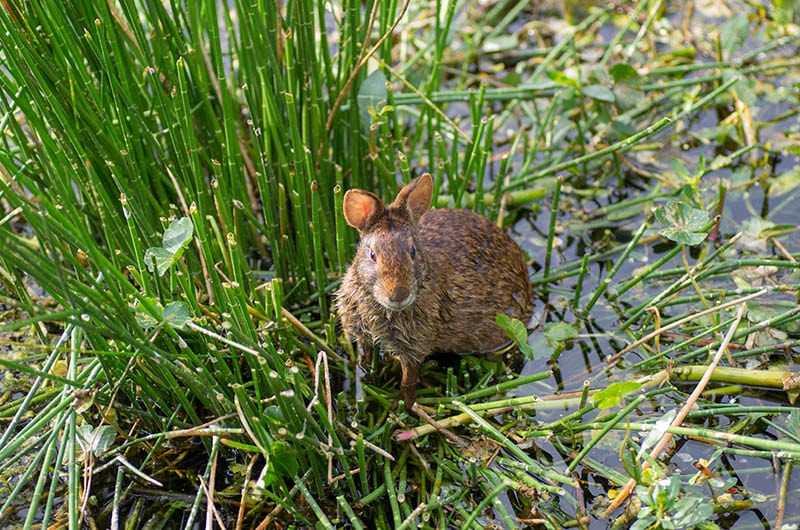Can Rabbits Swim? Facts & Safety Tips
Updated on

Rabbits are incredibly fascinating creatures with abilities that we keep on discovering. Swimming is one of rabbits’ abilities, but it depends on the type of rabbit. Wild rabbits have adapted to living in wet environments and are much more skilled in different situations. When the situation calls for it, they may effortlessly jump into the water and find their way out of a tricky situation.
Domesticated rabbits are much less skilled at swimming and don’t particularly enjoy this activity. Read more about the rabbit’s ability to swim in the article below.
Can Rabbits Swim?
Depending on the breed, some rabbits do swim and actually enjoy it. Some wild rabbits are known for being excellent swimmers and rely on their swimming skills to survive. Wild rabbits use their hindlimbs and their forelimbs to propel them through the water. While some domesticated rabbits can technically swim, most do not enjoy this activity as they have difficulty regulating their body temperature. A rabbit’s coat is quite sensitive and absorbs water quickly.
While rabbits can swim, allowing your rabbit into the pool is not recommended, since most rabbits only use their swimming ability as a survival instinct.
 The 4 Wild Rabbit Breeds That Swim
The 4 Wild Rabbit Breeds That Swim
As we’ve mentioned above, some rabbits use their swimming skills daily, and domesticated rabbits are not so fond of this activity. Below you can find two wild rabbit breeds that have to rely on swimming to survive and two breeds that are also skilled swimmers when the situation calls for it.
1. Swamp Rabbits

Swamp Rabbits are a breed of rabbits that inhabit swampy lowlands, river edges, and around creeks. They have dense fur that covers their bodies and are adapted to water. They are fantastic swimmers which are best seen when a predator is nearby. When predators threaten Swamp Rabbits, they jump into the water to swim away and may even rely on diving to avoid being caught. Due to their large bodies, they have the buoyancy to paddle their way out of a risky situation effortlessly.
2. Marsh Rabbits

Marsh Rabbits are easily recognized in the wild by their dark chestnut coats and gray tails. Their typical residency includes wooded floodplains and brackish tidal marshes. While Marsh Rabbits are common prey for larger animals and humans, they are not endangered due to their frequent breeding. Marsh rabbits have adapted to living in wet environments but don’t swim out of enjoyment but as a survival instinct.
3. White-Tailed Jackrabbit

The White-tailed Jackrabbit is a hare species common in meadows, plains, and prairies of western North America. They have very large bodies with long and powerful hind legs that allow them to move in the water when necessary. While the Jackrabbit can swim and is quite skilled at it, it will only use this ability to escape a predator.
4. Snowshoe Rabbit

The Snowshoe Rabbit is a wild rabbit with extremely large hindlimbs which resemble snowshoes and allow the rabbit to run a surprising 27 mph and jump up to 10 feet. While Swamp and Marsh Rabbits are excellent swimmers and use their aquatic abilities often, the Snowshoe Rabbit will only use this skill when absolutely needed. When a predator corners a Snowshoe Rabbit, they tend to jump into the water and swim as a last resort.
 Is It Safe to Let Your Rabbit Swim?
Is It Safe to Let Your Rabbit Swim?
When it comes to your domesticated rabbit and whether they can swim, it is best to keep them out of the water. For a pet rabbit, swimming can be dangerous, especially if you put your pet in the water abruptly. Rabbits have difficulty regulating their body temperature when under stress, so exposing them to a stressful situation will cause their temperature to become elevated. Pools can be extremely dangerous to rabbits because of the many chemicals they may contain. Chlorine can hurt the sensitive skin of a rabbit and cause eye irritation.

Final Thoughts
When it comes to the unique skill of swimming, wild rabbits are incredibly talented and skilled at using this skill to survive. They can effortlessly swim through swamps and marshes to get away from predators, find food, and search for a mate. While wild rabbits are somewhat skilled swimmers, domesticated rabbits do not possess this ability. They may be able to survive in water and find their way out but putting your pet rabbit in water can be extremely dangerous, and is not recommended.
Featured Image Credit: Image Maximum Photography, Shutterstock











